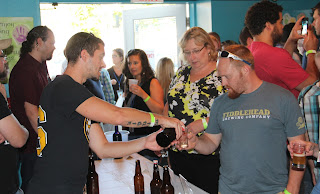September is the start of apple picking season in New
England. Apple picking is a great way to
spend your afternoon with families and kids.
They can see where the apples grow and look at all of the different
kinds.
 It’s not only fun to pick the apples, but they are good for
you too! Apples are a great, low calorie
fruit with no saturated fat or cholesterol. They are also filled with great vitamins such
as vitamin C and B-complex vitamins and minerals like calcium, potassium, and
phosphorus which make you healthy and strong.
It’s no wonder why they say an apple a day keeps the doctors away!
It’s not only fun to pick the apples, but they are good for
you too! Apples are a great, low calorie
fruit with no saturated fat or cholesterol. They are also filled with great vitamins such
as vitamin C and B-complex vitamins and minerals like calcium, potassium, and
phosphorus which make you healthy and strong.
It’s no wonder why they say an apple a day keeps the doctors away!
There are many different types of apples that grow in the
New England area that are great for apples, sauces and other snacks.
C.N. Smith Farm in East Bridgewater has a great list of apple varieties, harvest dates and uses. You can check it out here.
C.N. Smith Farm in East Bridgewater has a great list of apple varieties, harvest dates and uses. You can check it out here.
Here are some yummy treats you can make with apples:
Apple Cider
Nothing says fall like enjoying a nice cup of apple
cider. This cozy beverage can either be
served hot or cold. Many apple orchards
and stores sell apple cider, but if you are looking for a nice drink to make
with your kids and want your house to smell delicious, you can make it at home. For a recipe, click here!
Apple Pie
After a nice big dinner, apple pie is the best
dessert to serve in the fall and a great way to use all of the apples you
picked! Your kids can help you mix the
ingredients together as a great introduction to cooking in the kitchen.
Suggestion- Serve hot with vanilla ice cream and whipped
cream! For a recipe, click here!
A delicious snack or even a healthy baking
substitute for oil, this apple sauce is supper easy and everyone will love
it! All you need is some apples,
cinnamon, a Crockpot and mason jars to store. For a recipe, click here!
Caramel Apples
This fall treat is often seen at fairs and
carnivals, but you can also make it at home.
With this mini caramel apples recipe, you can serve them at fall parties
or gatherings and kids will be coming back for more. For a recipe, click here!
Apple Chips
 This crispy and crunchy snack is super easy to
make and a healthier alternative to potato chips. Just thinly slice your
apples, pour on some cinnamon and bake them in the oven for about two
hours. These are great to put in your
kids lunchbox or an after-school snack. These chips are so good that you might
want to make a batch for yourself too! For a recipe, click here!
This crispy and crunchy snack is super easy to
make and a healthier alternative to potato chips. Just thinly slice your
apples, pour on some cinnamon and bake them in the oven for about two
hours. These are great to put in your
kids lunchbox or an after-school snack. These chips are so good that you might
want to make a batch for yourself too! For a recipe, click here!
Apples and Peanut ButterIf you aren’t in the mood for
baking, kids will love their apples with peanut butter. You can even make these cute little
sandwiches and add in some granola or raisins.
Here are some great orchards to visit in the Southeastern Mass area to visit with your family this fall:
- · C.N Smith Farm Inc- East Bridgewater, MA
- · Fairmount Fruit Farm- Franklin, MA
- · Downse Orchard- Sherborn, MA
- · Wijcik Farm- Blackstone, MA
- · Belkin Family Lookout Farm-Natick, MA
Written by Stephanie Starbard- PR and Communications Intern

































.JPG)

.JPG)